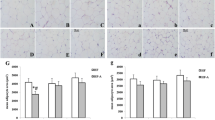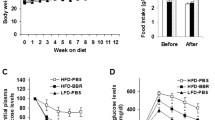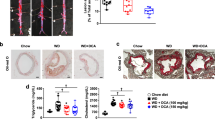Abstract
Rats treated with bezafibrate, a PPAR activator, gain less body weight and increase daily food intake. Previously, we have related these changes to a shift of thermogenesis from brown adipose tissue to white adipose tissue attributable to bezafibrate, which induces uncoupling proteins (UCP), UCP-1 and UCP-3, in rat white adipocytes. Nevertheless, UCP induction was weak, implying additional mechanisms in the change of energy homeostasis produced by bezafibrate. Here we show that bezafibrate, in addition to inducing UCPs, modifies energy homeostasis by directly inducing aco gene expression and peroxisomal fatty acid β-oxidation in white adipose tissue. Further, bezafibrate significantly reduced plasma triglyceride and leptin concentrations, without modifying the levels of PPARγ or ob gene in white adipose tissue. These results indicate that bezafibrate reduces the amount of fatty acids available for triglyceride synthesis in white adipose tissue.
Similar content being viewed by others
References
Klosiewicz-Latoszek L, Kozuka H: Comparative studies on the influence of different fibrates on serum lipoproteins in endogenous hyperlipoproteinemia. Eur J Clin Pharmacol 40: 33–41, 1991
Isseman Y, Green S: Activation of a member of the steroid hormone receptor superfamily by peroxisome proliferators. Nature 347: 645–650, 1990
Wahli W, Braissant O, Desvergne B: Peroxisome proliferator activated receptors: Transcriptional regulators of adipogenesis, lipid metabolism and more. Chem Biol 2: 261–266, 1995
Kersten S, Seydoux J, Peters JM, Gonzalez FJ, Desvergne B, Wahli W: Peroxisome proliferator-activated receptor alpha mediates the adaptive response to fasting. J Clin Invest 103: 1489–1498, 1999
Djouadi F, Weinheimer CJ, Saffitz JE, Pitchford C, Bastin J, Gonzalez FJ, Kelly DP: A gender-related defect in lipid metabolism and glucose homeostasis in peroxisome proliferator-activated receptor a-deficient mice. J Clin Invest 102: 1083–1091, 1998
Costet P, Legendre C, Moré J, Edgar A, Galtier P, Pineau T: Peroxisome proliferator-activated receptor alpha-isoform deficiency leads to progressive dyslipidemia with sexually dimorphic obesity and steatosis. J Biol Chem 273: 29577–29585, 1998
Poynter ME, Daynes RA: Peroxisome proliferator-activated receptor alpha activation modulates cellular redox status, represses nuclear factor-kappaB signaling, and reduces inflammatory cytokine production in aging. J Biol Chem 273: 32833–32841, 1998
Alegret M, Ferrando R, Vázquez M, Adzet T, Merlos M, Laguna JC: Relationship between plasma lipids and palmitoyl-CoA hydrolase and synthetase activities with peroxisomal proliferation in rats treated with fibrates. Br J Pharmacol 112: 551–556, 1994
Alegret M, Cerqueda E, Ferrando R, Vázquez M, Sánchez RM, Adzet T, Merlos M, Laguna JC: Selective modification of rat hepatic microsomal fatty acid chain elongation and desaturation by fibrates. Relationship with their activity as peroxisome proliferators. Br J Pharmacol 114: 1351–1358, 1995
Vázquez M, Muñoz S, Alegret M, Adzet T, Merlos M, Laguna JC: Differential effects of fibrates on the acyl composition of microsomal phospholipids in rats. Br J Pharmacol 116: 2067–2075, 1995
Vázquez M, Merlos M, Adzet T, Laguna JC: Decreased susceptibility to copper-induced oxidation of rat-lipoproteins after fibrate treatment: Influence of fatty acid composition. Br J Pharmacol. 117: 1155–1162, 1996
Cabrero A, Llaverias G, Roglans N, Alegret M, Sánchez R, Adzet T, Laguna JC, Vázquez M: Uncoupling protein-3 mRNA levels are increased in white adipose tissue and skeletal muscle of bezafibratetreated rats. Biochem Biophys Res Commun 260: 547–556, 1999
Dreyer C, Krey G, Keller H, Givel F, Helftenbein G, Wahli W: Control of the peroxisomal beta-oxidation pathway by fatty acids through activation of peroxisome proliferator-activated receptors (PPARs). Cell 68: 879–887, 1992
Lemberger T, Saladin R, Vázquez M, Assimacopoulos F, Staels B, Desvergne B, Wahli W, Auwerx J: Expression of the peroxisome proliferator-activated receptor a gene is stimulated by stress and follows a diurnal rhythm. J Biol Chem 269: 1764–1769, 1996
Montgomery MR, Cinti DL: Pyridine nucleotide-dependent electron transport in kidney cortex microsomes: Interaction between desaturase and other mixed function oxidases. Mol Pharmacol 13: 60–69, 1977
Bradford M: A rapid and sensitive method for the quantitation of microgram quantities of protein utilizing the principles of protein-dye binding. Anal Biochem 72: 248–254, 1976
Rodbell M: Effects of hormones on glucose metabolism and lipolysis. J Biol Chem 239: 375–380, 1963
Cayen MN: Disposition, metabolism and pharmacokinetics of antihyperlipidemic agents in laboratory animals and man. Pharmacol Ther 29: 157–204, 1985
Lazarow PB: Assay of peroxisomal β-oxidation of fatty acids. Meth Enzymol 72: 315–319, 1981
Peters JM, Hennuyer N, Staels B, Fruchart JC, Fievet C, Gonzalez FJ, Auwerx J: Alterations in lipoprotein metabolism in peroxisome proliferator-activated receptor alpha-deficient mice. J Biol Chem 272: 27307–27312, 1997
Lock EA, Mitchell AM, Elcombe CR: Biochemical mechanisms of induction of hepatic peroxisome proliferation. Annu Rev Pharmacol Toxicol 29: 145–163, 1989
Schoonjans K, Staels B, Auwerx J: The peroxisome proliferator activated receptors (PPARs) and their effects on lipid metabolism and adipocyte differentiation. Biochim Biophys Acta 1302: 93–109, 1996
Inoue I, Noji S, Man-zhen S, Takahashi K, Katayama S: The peroxisome proliferator-activated receptor α (PPARα) regulates the plasma thiobarbituric acid-reactive substance (TBARS) level. Biochem Biophys Res Commun 237: 606–610, 1997
Halaas JL, Gajiwala KS, Maffei M, Cohen SL, Chait BT, Rabinowitz D, Lallone RL, Burley SK, Friedman JM: Weight reducing effects of the plasma protein encoded by the obese gene. Science 269: 543–546, 1995
Saladin R, De Vos P, Guerre-Millo M, Leturque A, Girard J, Staels B, Auwerx J: Transient increase in obese gene expression after food intake or insulin administration. Nature 377: 527–529, 1995
Villarroya F, Giralt M, Iglesias R: Retinoids and adipose tissues: Metabolism, cell differentiation and gene expression. Int J Obes 23: 1–6, 1999
Tontonoz P, Hu E, Spiegelman BM: Stimulation of adipogenesis in fibroblasts by PPARγ2, a lipid-activated transcription factor. Cell 79: 1147–1156, 1994
Caro JF, Sinha MK, Kolaczynski JW, Zhang PL, Considine RV: Leptin: The tale of an obesity gene. Diabetes 45: 1455–1462, 1996
Ogawa S, Takeuchi K, Sugimura K, Fukuda M, Lee R, Ito S, Sato T: Bezafibrate reduces blood glucose in type 2 diabetes mellitus. Metabol Clin Exp 49: 331–334, 2000
Braissant O, Foufelle F, Scotto C, Dauça M, Wahli W: Differential expression of peroxisome proliferator-activated receptors (PPARs): Tissue distribution of PPAR-α,-β and-γ in the adult rat. Endocrinology 137: 354–366, 1996
Staels B, van Tol A, Andreu T, Auwerx J: Fibrates influence the expression of genes involved in lipoprotein metabolism in a tissue-selective manner in the rat. Arterioscler Thromb 12: 286–294, 1996
Baillie RA, Takada R, Nakamura M, Clarke SD: Coordinate induction of peroxisomal acyl-CoA oxidase and UCP-3 by dietary fish oil: a mechanism for decreased body fat deposition. Prost Leuk Essen Fatty Acids 60: 351–356, 1999
Schoonjans K, Peinado-Onsurbe J, Lefebvre A-M, Heyman RA, Briggs M, Deeb S, Staels B, Auwerx J: PPARα and PPARγ activators direct a distinct tissue-specific transcriptional response via a PPRE in the lipoprotein lipase gene. EMBO J 19: 5336–5348, 1996
De Vos P, Lefebvre A-M, Miller SG, Guerre-Millo M, Wong K, Saladin R, Hamann LG, Staels B, Briggs MR, Auwerx J: Thiazolidinediones repress ob gene expression in rodents via activation of peroxisome proliferator-activated receptor γ. J Clin Invest 4: 1004–1009, 1996
Brandt JM, Djouadi F, Kelly DP: Fatty acids activate transcription of the muscle carnitine palmitoyltransferase I gene in cardiac myocytes via the peroxisome poliferator-activated receptor γ. J Biol Chem 273: 23786–23792, 1998
Brown PJ, Winegar DA, Plunket KD, Moore LB, Lewis MC, Wilson JG, Sundseth SS, Koble CS, Wu Z, Chapman JM, Lehmann JM, Kliewer SA, Willson TM: A ureido-thioisobutiric acid (GW9578) is a subtypeselective PPARa agonist with potent lipid-lowering activity. J Med Chem 42: 3785–3788, 1999
Basu-Modak S, Braissant O, Escher P, Desvergne B, Honegger P, Wahli W: Peroxisome proliferator-activated receptor β regulates acyl-CoA synthetase 2 in reaggregated rat brain cell cultures. J. Biol. Chem. 274: 35881–35888, 1999
Author information
Authors and Affiliations
Corresponding author
Rights and permissions
About this article
Cite this article
Vásquez, M., Roglans, N., Cabrero, Á. et al. Benzafibrate induces acyl-CoA oxidase mRNA levels and fatty acid peroxisomal β-oxidation in rat white adipose tissue. Mol Cell Biochem 216, 71–78 (2001). https://doi.org/10.1023/A:1011060615234
Issue Date:
DOI: https://doi.org/10.1023/A:1011060615234




